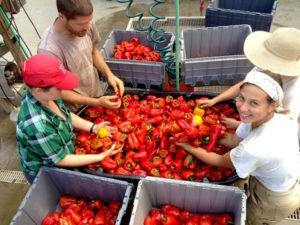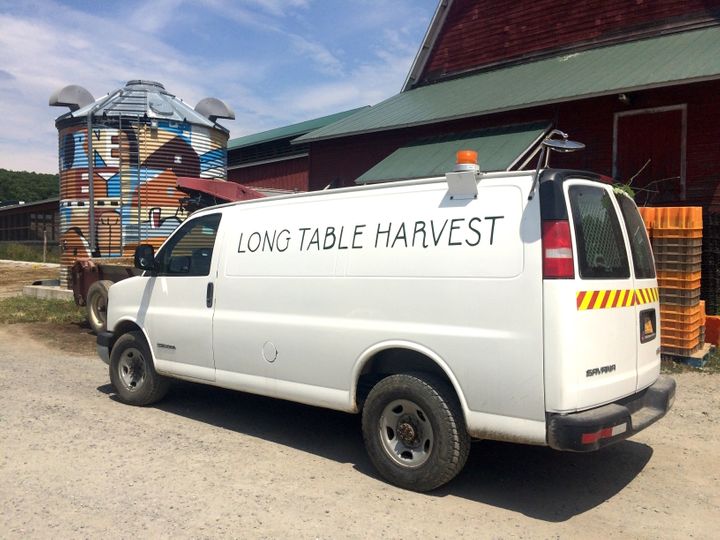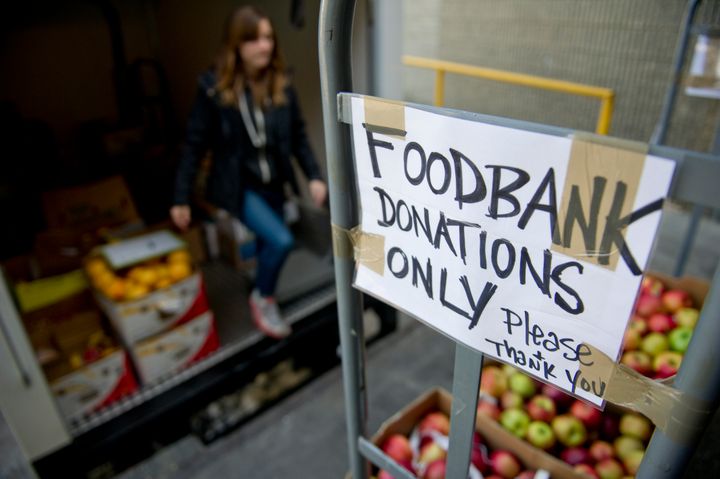Source: huffingtonpost.com
Published: August 13, 2016

Audrey Berman (right) founded Long Table Harvest, a food recovery organization, earlier this year. They’ve already saved many van loads of produce, but getting funding has been tough. Long Table Harvest
Audrey Berman is no stranger to the farming life.
Over the last three years, Berman has worked on various farms in New York’s Hudson Valley with the intention of one day starting her own farm. But it wasn’t too long before she started to notice disheartening trends.
“We always had to plant more than we could actually harvest ourselves,” Berman told The Huffington Post. “And the demographic we were selling [our food] to was a little more wealthy and well-to-do while, at the same time, good food wasn’t accessible to everyone and a lot of that had to do with affordability. It started to bother me.”
She began to research what she could do about it. And that led to the launch earlier this year of Long Table Harvest, a food recovery group.
Led by Berman and co-founder Laura Engelman, the group works with 16 farms in the Hudson Valley to collect their surplus fruits and vegetables — which would otherwise go to waste — and distribute them to food pantries, community organizations and other charities throughout the region.
A certain amount of surplus is practically inevitable on farms. Farmers plant more crops than they’ll need for their buyers to protect against losses from pests, weather and other issues. Oftentimes, it’s cheaper for farms to let the surplus rot in the fields rather than pay for the labor to harvest it.
Each Monday, Berman and her small team travel to their donor farms to pick up market leftovers and other extras farms have to offer. They fill up their van and drop off the proceeds at their recipient sites.
In June, the organization was picking up about 940 pounds of produce a week. Two months later, that number has grown to about 1,100 weekly pounds of summer staples like watermelon, cantaloupe, peppers, cucumbers, tomatoes and corn.
“It’s all really high quality, all really beautiful and the people receiving it are all excited to get it,” Berman said.
Groups like this often operate under the radar and struggle to make ends meet. Their work ― known as gleaning ― is an ancient practice, one that dates back at least to the days of the Old Testament.
It is written in the Bible that Ruth would glean the fields of the well-to-do farmer Boaz, collecting any produce left after harvest was completed and redistributing it to the poor. The practice is said to have continued in Europe throughout the Middle Ages, too.
Today, gleaning is experiencing a resurgence of interest as Americans become aware of the estimated 70 billion pounds of food the country wastes each year. Some of this loss is due to surpluses on farms. As a result, recovery groups like Long Table Harvest have popped up across the country ― the National Gleaning Project lists more than 400 food recovery organizations ― and are likely saving many tons of food from being left to rot in farmers’ fields or sent to landfills.
While there is no national estimate for how much food these groups are diverting to people who need it, some organizations reclaim hundreds of thousands of pounds each year. Oregon’s Salem Harvest, for example, gleans 300,000 pounds of fresh produce annually.
It’s safe to assume these organizations, collectively, are preventing millions of pounds of produce from being tossed each year.

Long Table Harvest. Long Table Harvest’s van gets filled many times over during the busy summer months when bumper crops and other factors can leave farmers with surpluses.
Funding this work is a challenge, however. Berman and her Long Table Harvest team worked diligently applying for grants and fundraising ahead of their launch; an Indiegogo campaign raised over $11,000. But their operation has been limited in size, with just one van and one paid staff member, because they haven’t been able to secure major funding.
While financial struggles are not unusual for nonprofits of all kids, food recovery organizations appear to be facing unique challenges. Among them is that there is little federal or state-level grant funding available for this work, though the farmers who donate their surplus to food recovery groups can receive tax incentives in many states.
One initiative offered through the U.S. Department of Agriculture is the Community Food Projects competitive grant program, which was funded most recently at the level of $8.6 million. Though gleaners are eligible for this grant, which focuses on meeting the food needs of low-income communities through food distribution and community outreach, it is not specifically catered to food recovery.
Some states, like New Jersey, do offer grants specifically geared toward gleaners, but these programs are not particularly common.

Ann Hermes/The Christian Science Monitor via Getty Images Lovin’ Spoonfuls’ Meg Kiley loads donated produce onto a truck during a 2013 pickup from Whole Foods. Their group picks up surplus fruits and vegetables from stores and farms.
Most organizations rely overwhelmingly on individual donors, fundraising and corporate support to sustain their operations.
The Ithaca, New York-based Friendship Donations Network, a gleaning group, noted that while it does receive support from local foundations, it has never received state or federal funding and derives about 70 percent of its operating budget from individual donations.
Another prominent food recovery group, the Boston-based Lovin’ Spoonfuls, said it currently receives no government support and also depends primarily on individual donors, events and grants from local groups.
That funding just isn’t enough. Food recovery is “chronically underfunded at every step,” Dana Gunders, a staff scientist specializing in food waste at the Natural Resources Defense Council, told HuffPost earlier this summer.
The lack of financial support is also reflected in gleaning groups’ heavy reliance on volunteers to gather surplus produce from participating farmers. Though well-meaning, these volunteers typically aren’t particularly accustomed to the task at hand and don’t tend to work all that efficiently.
“Gleaning is good, but it’s not the most efficient way to get produce off the farm, even for donation, in terms of getting large volumes,” Gunders added. “Volunteers picking stuff are not trained and not nearly as fast” as farmworkers, she said.
In addition, gleaning groups often struggle to gain the attention of media and potential funders when compared to flashier food waste solutions.
“There’s a lot of excitement around people who are making apps or making a big splash in terms of media and promotional campaigns,” Berman said. “I’m really trying to do the work and connect the farmers with our recipients at our distribution sites and I’m not out there proselytizing the work. I’m trying to figure out the balance to that, but it’s a little disheartening.”
Though the practice of gleaning is far from groundbreaking, Jordan Figueiredo, the anti-food waste activist behind the Ugly Fruit and Veg campaign and a petition drive asking Walmart to more widely sell cosmetically imperfect produce, agreed that it’s deserving of more support.
“Overall, I think technology is not the answer [to food waste],” Figueiredo said. “I see those articles all the time — ‘The App That’s Going to End Food Waste.’ No one app is going to do that or make a big dent, even. Overall, it’s about valuing [food] enough so that we’re paying attention to the easy, old solutions like gleaning and putting money into them.”
Despite all the obstacles faced by groups like hers, Berman is optimistic that change is happening as Americans begin to value food more — and are adopting that mindset in their neighborhood grocery stores and kitchens.
“The biggest impact we can have is with ourselves and the decisions we make as individuals. How we live our life, what we buy and [do] not buy, what we cook and don’t cook,” Berman added. “If people say, ‘Hey, I’m a part of what seems like this big problem, but I can start with myself,’ I think that would be really exciting.”
